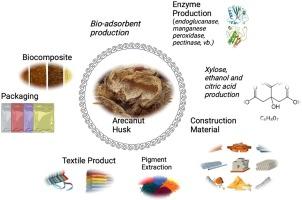Areca nut husk lignocellulosic fibers: A sustainable alternative to synthetic textiles
IF 5.8
2区 化学
Q1 POLYMER SCIENCE
引用次数: 0
Abstract
This review paper explores the potential of Areca nut husk fibers as a sustainable alternative to synthetic textiles, focusing on their composition, properties, extraction methods, and applications. Areca nut husk, a lignocellulosic material rich in cellulose, hemicellulose, and lignin, is an abundant agricultural by-product in regions like India. Despite its current underutilization, it exhibits excellent mechanical and thermal properties, making it suitable for diverse applications, including biocomposites, biodegradable packaging, textiles, and construction materials. The review highlights the extraction and processing techniques for optimizing fiber quality, such as alkaline treatment, and discusses the fibers’ advantages, such as renewability, biodegradability, and cost-effectiveness. The environmental impact assessment underscores the ecological benefits of replacing synthetic fibers with Areca nut husk fibers, emphasizing their potential to reduce carbon emissions and waste. While the fibers show promise in multiple industries, the paper also addresses current challenges and the need for further research to fully realize their potential as a green alternative to synthetic fibers.

亚麻仁壳木质纤维:合成纺织品的可持续替代品
本综述论文探讨了阿雷卡果壳纤维作为合成纺织品可持续替代品的潜力,重点关注其成分、特性、提取方法和应用。阿雷卡果壳是一种富含纤维素、半纤维素和木质素的木质纤维素材料,在印度等地区是一种丰富的农副产品。尽管目前其利用率不高,但它具有优异的机械和热性能,因此适合多种应用,包括生物复合材料、可生物降解包装、纺织品和建筑材料。综述重点介绍了优化纤维质量的提取和加工技术,如碱性处理,并讨论了纤维的优势,如可再生性、生物降解性和成本效益。环境影响评估强调了用阿雷卡果壳纤维替代合成纤维的生态效益,强调了其减少碳排放和废物的潜力。虽然这种纤维在多个行业都大有可为,但论文也谈到了当前的挑战和进一步研究的必要性,以充分发挥其作为合成纤维绿色替代品的潜力。
本文章由计算机程序翻译,如有差异,请以英文原文为准。
求助全文
约1分钟内获得全文
求助全文
来源期刊

European Polymer Journal
化学-高分子科学
CiteScore
9.90
自引率
10.00%
发文量
691
审稿时长
23 days
期刊介绍:
European Polymer Journal is dedicated to publishing work on fundamental and applied polymer chemistry and macromolecular materials. The journal covers all aspects of polymer synthesis, including polymerization mechanisms and chemical functional transformations, with a focus on novel polymers and the relationships between molecular structure and polymer properties. In addition, we welcome submissions on bio-based or renewable polymers, stimuli-responsive systems and polymer bio-hybrids. European Polymer Journal also publishes research on the biomedical application of polymers, including drug delivery and regenerative medicine. The main scope is covered but not limited to the following core research areas:
Polymer synthesis and functionalization
• Novel synthetic routes for polymerization, functional modification, controlled/living polymerization and precision polymers.
Stimuli-responsive polymers
• Including shape memory and self-healing polymers.
Supramolecular polymers and self-assembly
• Molecular recognition and higher order polymer structures.
Renewable and sustainable polymers
• Bio-based, biodegradable and anti-microbial polymers and polymeric bio-nanocomposites.
Polymers at interfaces and surfaces
• Chemistry and engineering of surfaces with biological relevance, including patterning, antifouling polymers and polymers for membrane applications.
Biomedical applications and nanomedicine
• Polymers for regenerative medicine, drug delivery molecular release and gene therapy
The scope of European Polymer Journal no longer includes Polymer Physics.
 求助内容:
求助内容: 应助结果提醒方式:
应助结果提醒方式:


